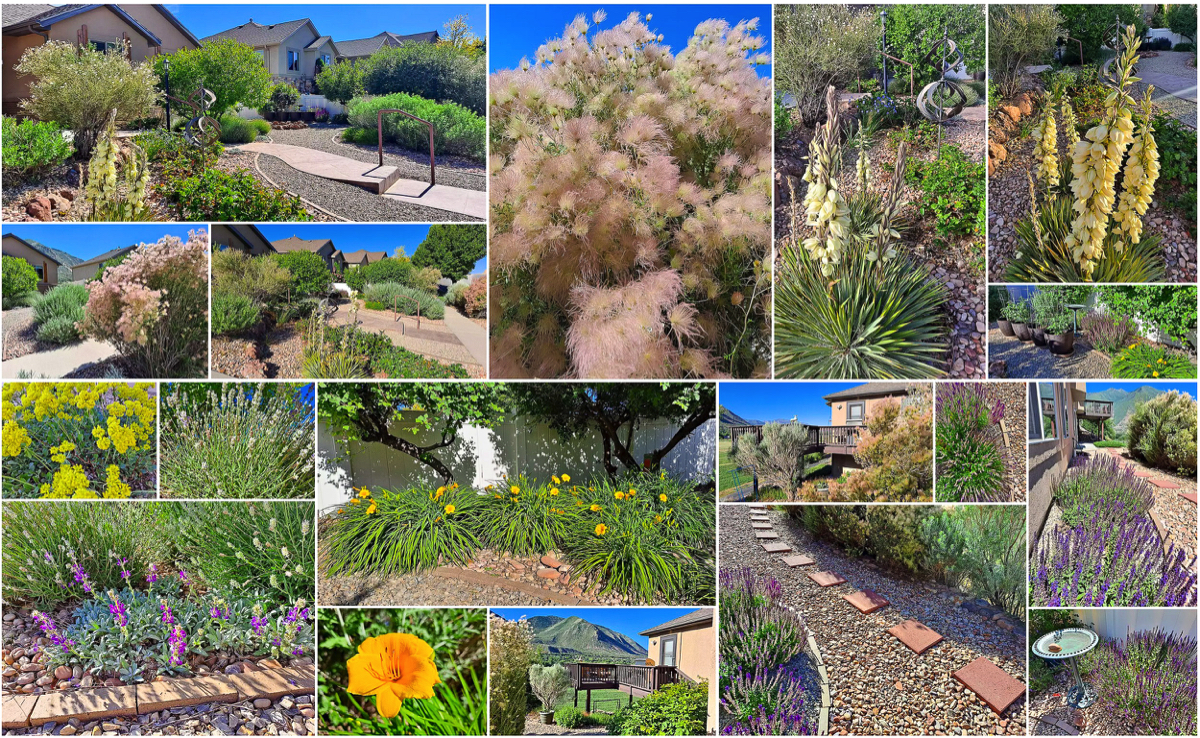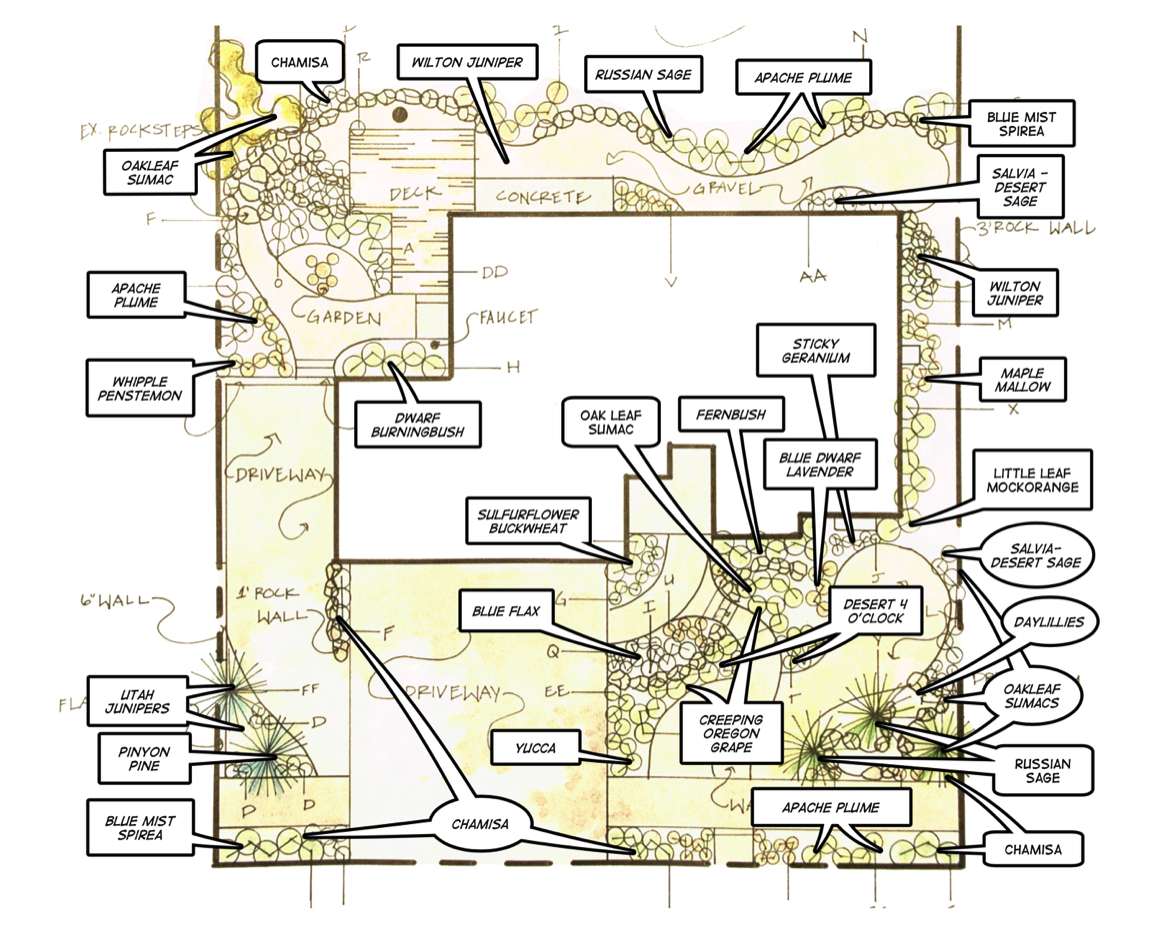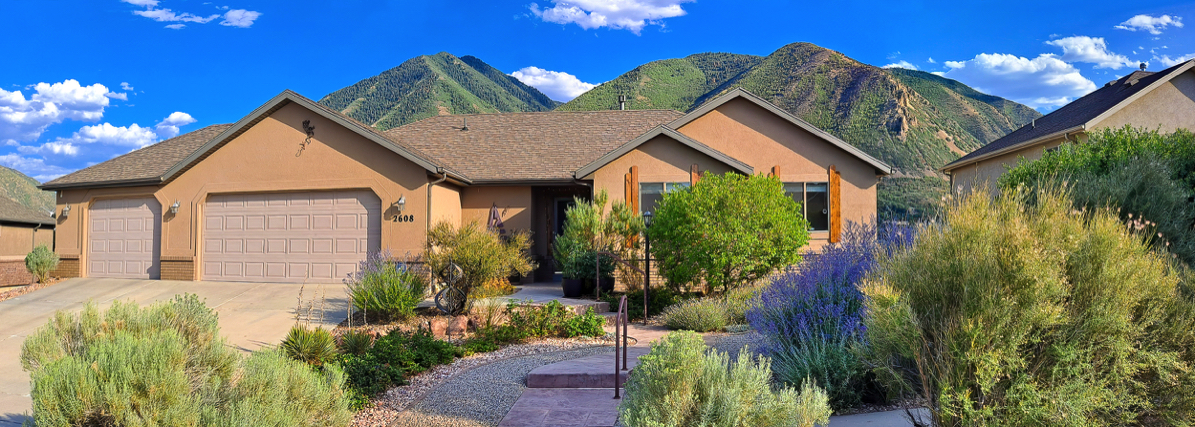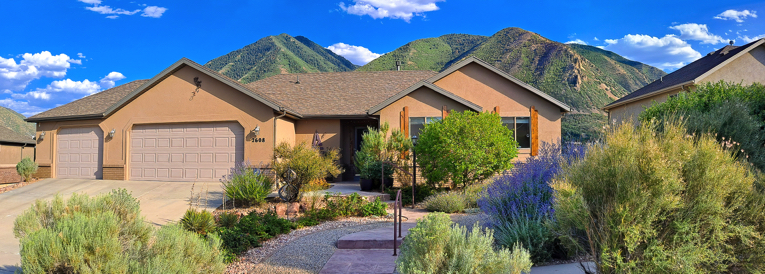DESIGN YOUR OWN: Some people think that landscapes which conserve water have to be composed of gravel, cactus, and other desert plants. This simply isn’t true. Water-efficient landscapes can be very diverse, colorful and functional. Water-efficient landscaping is actually a set of seven steps. Each step causes increased water savings in landscapes. Of course, you can hire a ladscape designer if you wish, or DYI.
1. Planning and Design
Planning comprehensively from the beginning allows homeowners to tailor their landscapes to their particular needs and interests. Consider whether there is a need for recreational areas, food production areas, or utility areas. During the design process, identify the sun and shade patterns in your landscape. Note whether there are views that you would like to block or views you want to preserve. Observe any drainage or other soil problems that need to be remedied before planting.
2. Soil Analysis
Soils high in clay absorb water very slowly and cause water waste when unabsorbed water runs off. Sandy soils are very porous and water moves past plant root zones too quickly. Improve the soil in your landscape by incorporating organic matter such as compost. This will improve the drainage and water penetration of clay soils and increase the water-holding capacity of sandy soils.
3. Plant Selection
Select plants that are appropriate for the climate and soil in our area. There are numerous colorful, attractive, water-efficient plants that require less water than traditional plants. Group plants with similar water needs in the same areas. Plants can be grouped into categories such as high water need (lawn areas), moderate, low, and very low, with irrigation planned to fit specific plant needs.
4. Lawn Areas
Lawn has practical function for recreation areas because of its durability as a ground-cover. Remember to create lawn areas of practical size and locate them where they will be most used. Alternative grasses such as tall fescue that require less water than traditional bluegrass are becoming increasingly available.
5. Efficient Irrigation
Water infrequently and deeply to encourage plants to develop deep root systems. Consider using micro-sprays, drip lines, or bubblers for planting beds. These can reduce water loss from evaporation and wind. Remember to routinely check your sprinkler system for leaks, broken or tilted heads, etc. Adjust automatic sprinkler clocks as the weather changes.
6. Use of Mulches
Spreading mulch in planting beds and under trees helps cool the soil and minimize evaporation. A thick layer of mulch (3 inches) will also help reduce the number of germinating weeds. Mulch material can be organic, such as wood chips or bark chips, or inorganic, such as river rock or gravel. Bugs, wind, rain, sun and time don’t affect rock mulch much. Mulch also adds a finished look to the landscape.
7. Proper Maintenance
All landscapes require regular maintenance. Pruning, correct watering and disease and pest monitoring will keep your plants healthy. Controlling weeds in you landscape is important because weeds typically have deep root systems and compete with landscape plants for water, nutrients, and space. Fertilize only the minimum amount needed. Excess fertilizer actually increases water consumption. Investigate the possible causes of yellowing plant leaves or other plant symptoms. People often assume a problem plant needs more water, when a symptomatic plant could just as easily be over-watered or suffering from a pest infestation.

XERISCAPE

1. Saves water: We drip-irrigate and have not incurred a bill for the pressuriezed irrigation (PI) water we’ve used for over 18 years!
2. Saves time and labor: There is no mowing, trimming, aeration or pest control. Bugs don’t eat rocks. And we don’t need to replace plants eaten by deer or grass killed by grubs, etc..
3. Saves energy: It’s quick and easy to maintain. No need to run noisy, air-polluting mowers, trimmers, blowers, edgers, aerators and chemical spreaders, etc.
4. Saves money: It saves LOTS of money! Lawn mowing in the US costs on average $800 to $1,000/year. Add to that the water bill and servicing sprinklers. Xeriscaping costs more to put in but in the long run it's a real winner!!!
5. Cuts air and noise pollution: We don’t need to run noisy, air-polluting power equipment.
6. Helps Polinators, Bio-Diversity and Wildlife: The birds and bees love our xeriscape!
7. Cuts water and land pollution: We don’t need pest control chemicals, fertilizers or much in way of herbicides that can eventually end up in Utah Lake.
8. Looks attractive: Xeriscaping can add beauty, color, textures, shapes and levels to a lawn, and “curb appeal” to a home. It does take time to grow.
9. Reduces waste: There is much reduced green waste to be disposed of. Some trimming is needed.
10. Xeriscaping sets a good example of responsible stewardship of creation.

What is Xeriscape? It’s low-water, or water-smart landscaping. Not zeroscape!
“Xeri” means dry in Greek.
Why Xeriscape? We live in a semi-arid region where water is not plentiful. Xeriscaping is smart landscaping and has many benefits ...


Below is the design for the pictured home.
The rest of the backyard is hillside which is left natural.
If you'd like to view this xeriscape first hand,
send an email request to Xeriscape@UVEF.org.
Before
Web design and photography
© 2021 James Westwater


After
To help the
Utah Valley Earth Forum
